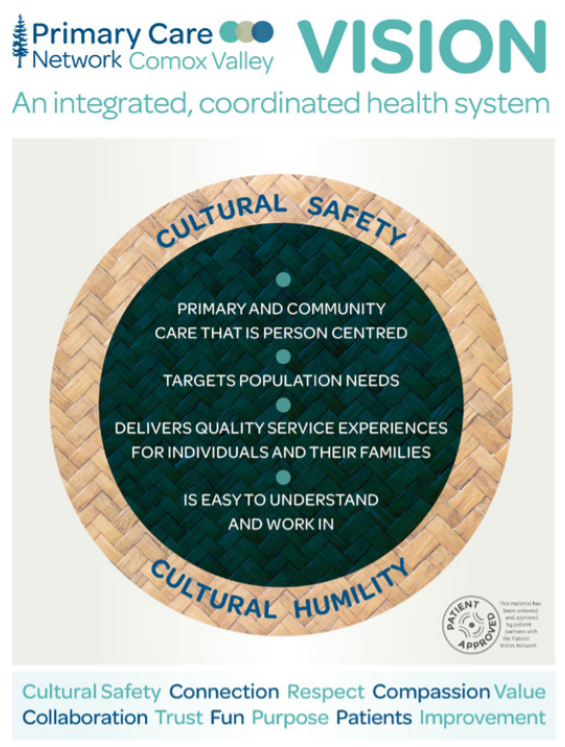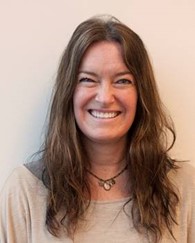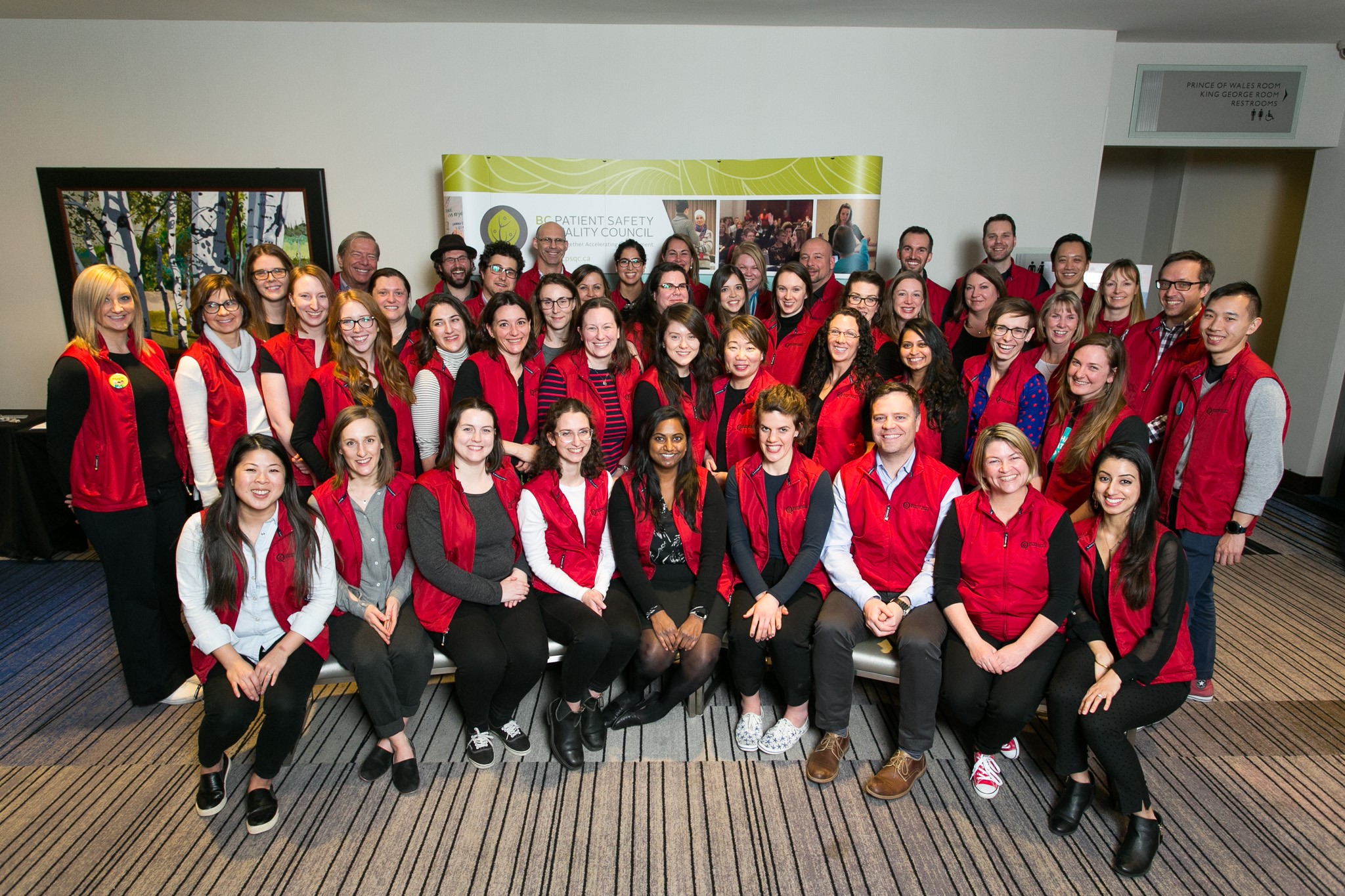Posted
Categories: Working Together for Better Health Care
In September 2020, the Ministry of Health announced the creation of a Primary Care Network (PCN) in the Comox Valley as part of the government’s Primary and Community Care Strategy focused on team-based care.
The Comox Valley PCN is a partnership between Métis, Inuit and First Nations communities, Island Health, Comox Valley Division of Family Practice and the broader Comox Valley community. Creating a new model of care for a community is no small feat! This multi-year initiative began in April 2018 when Comox Valley was one of the first five communities in BC identified to develop a PCN. Despite the pandemic striking in early 2020, the momentum continued with the establishment of working groups, stakeholder engagements and recruitment of more staff.
In early 2021, the operating model was implemented. To date, the Comox Valley PCN involves 10 medical clinics, 45+ participating family physicians and over 76 individuals supporting the implementation of the PCN across various groups.
Patient Partner Involvement
“Patients are at the centre of care in a Primary Care Network – it’s a core principle. So, we recognized early on that the patient voice was very important to this work,” said Maureen Clarke, a Leader, Health System Improvement at the BC Patient Safety & Quality Council and the Change Lead for the Comox Valley PCN.
Patient partner Edna Leask has been involved from the start, sitting on the network’s steering committee as well as its Indigenous Health Working Group. “I wanted to see change in health care and delivery for Indigenous Peoples. I really think it’s important for Indigenous patients to have their own doctor, and to have that attachment and relationship with them. That connection and relationship is so important – it gives people some control over their health care. By developing a relationship, you get to know the person, the person gets to know you, and you have more say into your health and wellness,” she said.
Edna is one of four patient partners who are involved in the Comox Valley PCN. Two sit on the steering committee as full voting members and are involved in developing the network’s governance structure. Plus, there is one on each of its five working groups: Indigenous Health, Virtual Care, Measurement & Evaluation, Community Wellness Collaborative-Vulnerable Populations, and Team-Based Care. They also review patient-facing communications materials and join feedback loops to continually monitor and evaluate new changes.
Cultural Safety and Connections with Local First Nations
The Comox Valley PCN is committed to embedding cultural safety in its work as a team and within its approach by connecting with local First Nations to better understand and incorporate Indigenous perspectives on health and wellness, and referring to the PCN Guidebook for Indigenous Engagement & Cultural Safety. It has also developed a Culturally Informed Team-Based Care Learning Journey – a professional development standard for those providing care within a PCN that includes a localized Indigenous knowledge learning series and a cultural safety community of practice.

“I think it is really important for people in health care professions, if they have questions, to go seek out answers,” Edna said. “Sit down with someone. The elders that are on the primary care committee, any one of us, would be willing to sit down with them and talk about this very important and delicate subject. It really speaks to the health and well-being of everyone involved in primary care – the practitioners and professionals – everyone has to take care of themselves and that’s another way of taking care of yourself, by getting answers and talking about it, and being open and compassionate.”
In addition to contributing to the Learning Journey, Edna and the other patient partners have provided insights into the language and imagery used in communications to ensure they are culturally sensitive and will be well-received by Indigenous communities.
“Patient partners have also been the voice in developing two new positions that we’ve recruited for, specifically the Indigenous Wellness Liaison role and the Indigenous Wellness Advocate role,” shared Maureen. “Having Edna, an Indigenous Elder, as a steering committee member and active member on many committees and groups has contributed significantly to our own learning and knowledge of Indigenous Peoples and Indigenous perspectives on health. This has supported us in building deep relationships with our Indigenous partners,” she said.
COVID Challenges
Despite the progress they have made over the last year, Maureen commented on the challenge that COVID-19 presented with respect to community development.
“Many of our patient partners experience some sort of health risk already, so face-to-face interactions, even socially distanced, were a concern. Not having casual, one-to-one, face-to-face meetings has been a challenge. I think we have all experienced some feelings of loss around that. It really impacted our ability to bring the patient partner team together as it grew. Zoom isn’t the same as popping a box of donuts down on the table and having coffee with everyone, which is what we really wanted to do,” Maureen said. “But it did bring the patient voice closer to the surface of our meetings, because COVID was all about patients! So, in some ways I saw patient partners speaking up more about their concerns and the need for system change that maybe would not have surfaced as readily without COVID.”
Reflections, Advice & Lessons Learned
“Start early!” is Maureen’s advice to health care teams regarding patient engagement. “At the very beginning stages. The first person you need to find for your project or program is a patient partner. Then have them bring their friends.” The idea of bringing friends was an aha moment for the PCN team, noting that patient partners were keen to take ideas and materials back to their own circles of friends and family for feedback.
“Each patient partner is an individual within their own network and tapping into those was a more extensive way to access the public for feedback. It’s been successful and enjoyable for everyone,” Maureen said.
Edna encourages patient partners to speak up and share opinions. “Put yourself out there. Say what you’re thinking because you’re not going to help anyone by holding it back. All that’ll do is bug you. I really believe that. I’ve been an advocate my whole life. It’s really important for justice and balance and harmony and compassion and kindness to be included and considered in the policies and laws that govern us.”
Reflecting on the sum of her involvement to date, Edna shared that the highlights have been the relationships and people she has worked with who are so dedicated and determined to see changes. “I appreciate that. It has been very interesting, and I’m glad that I got involved to contribute. I’ve enjoyed meeting and working and conversing with them and understanding that we all have human frailties – we all want health and wellness for everybody. We all basically want the same thing.”
This story was featured in our 2020/21 Annual Report. Read more like it here.


